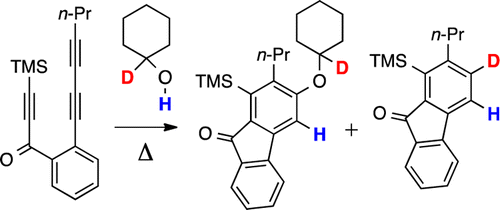Willoughby, P. H.; Niu, D.; Wang, T.; Haj, M. K.; Cramer, C. J.; Hoye, T. R. J. Am. Chem. Soc. 2014, 136, 13657–13665.
We have studied reactions of secondary and primary alcohols with benzynes generated by the hexadehydro-Diels–Alder (HDDA) reaction. These alcohols undergo competitive addition vs dihydrogen transfer to produce aryl ethers vs reduced benzenoid products, respectively. During the latter process, an equivalent amount of oxidized ketone (or aldehyde) is formed. Using deuterium labeling studies, we determined that (i) it is the carbinol C–H and adjacent O–H hydrogen atoms that are transferred during this process and (ii) the mechanism is consistent with a hydride-like transfer of the C–H. Substrates bearing an internal trap attached to the reactive, HDDA-derived benzyne intermediate were used to probe the kinetic order of the alcohol trapping agent in the H2-transfer as well as in the alcohol addition process. The H2-transfer reaction is first order in alcohol. Our results are suggestive of a concerted H2-transfer process, which is further supported by density functional theory (DFT) computational studies and results of a kinetic isotope effect experiment. In contrast, alcohol addition to the benzyne is second order in alcohol, a previously unrecognized phenomenon. Additional DFT studies were used to further probe the mechanistic aspects of the alcohol addition process.
